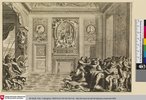
"Philomela (/ˌfɪləˈmiːlə/) or Philomel (/ˈfɪləˌmɛl/; Greek: Φιλομήλη, Philomēlē) is a minor figure in Greek mythology who is frequently invoked as a direct and figurative symbol in literary and artistic works in the Western canon.
She is identified as being the "princess of Athens" and the younger of two daughters of Pandion I, King of Athens, and Zeuxippe. Her sister, Procne, was the wife of King Tereus of Thrace. While the myth has several variations, the general depiction is that Philomela, after being raped and mutilated by her sister's husband, Tereus, obtains her revenge and is transformed into a nightingale (Luscinia megarhynchos), a bird renowned for its song. Because of the violence associated with the myth, the song of the nightingale is often depicted or interpreted as a sorrowful lament. In nature, the female nightingale is actually mute, and only the male of the species sings." - (en.wikipedia.org 11.08.2021)
 )
)
